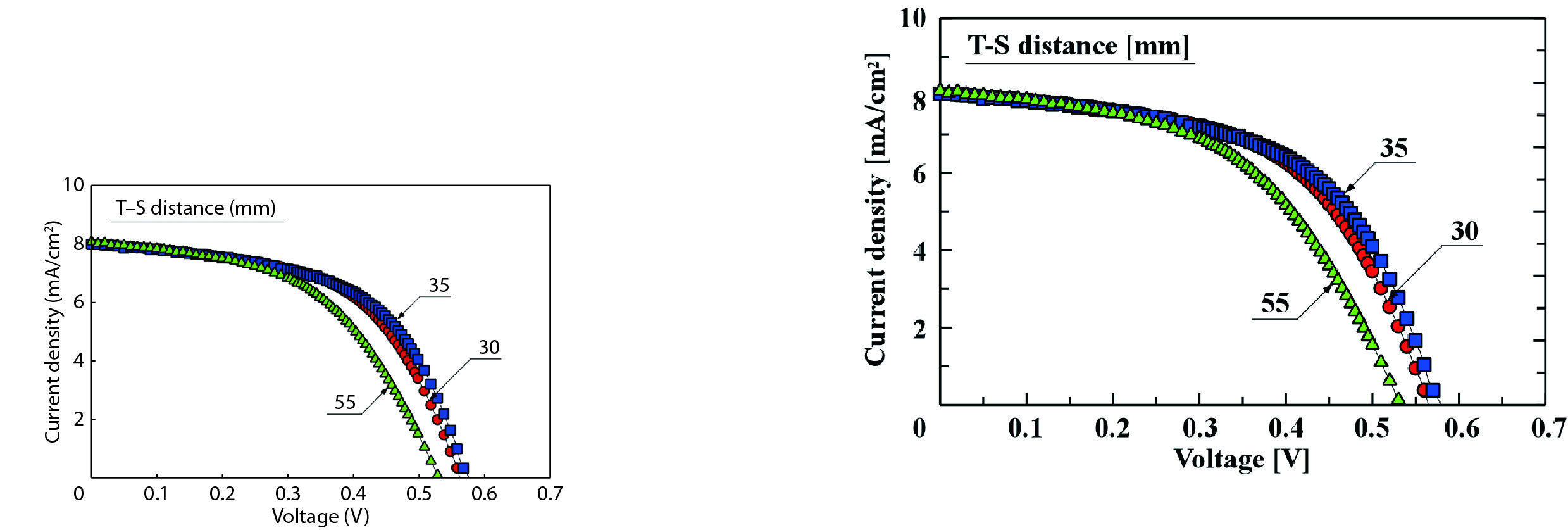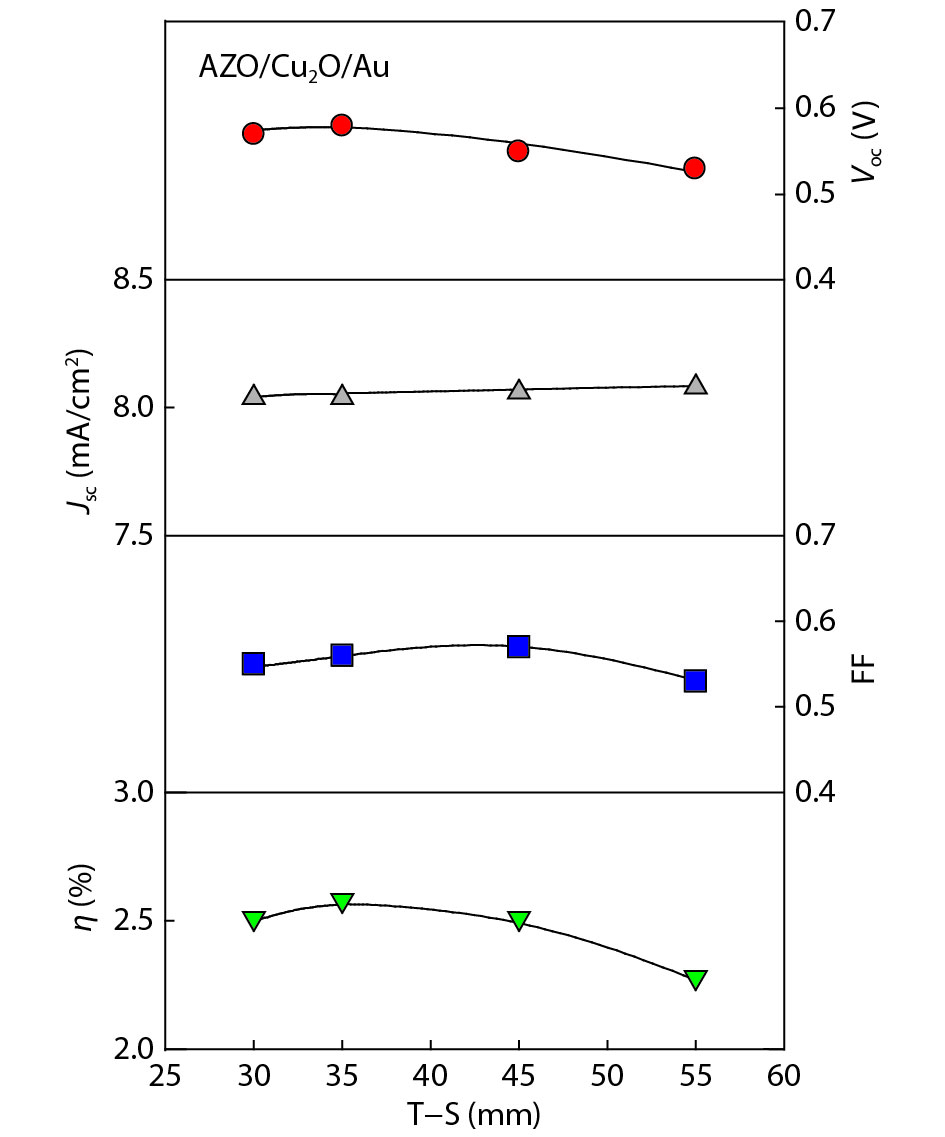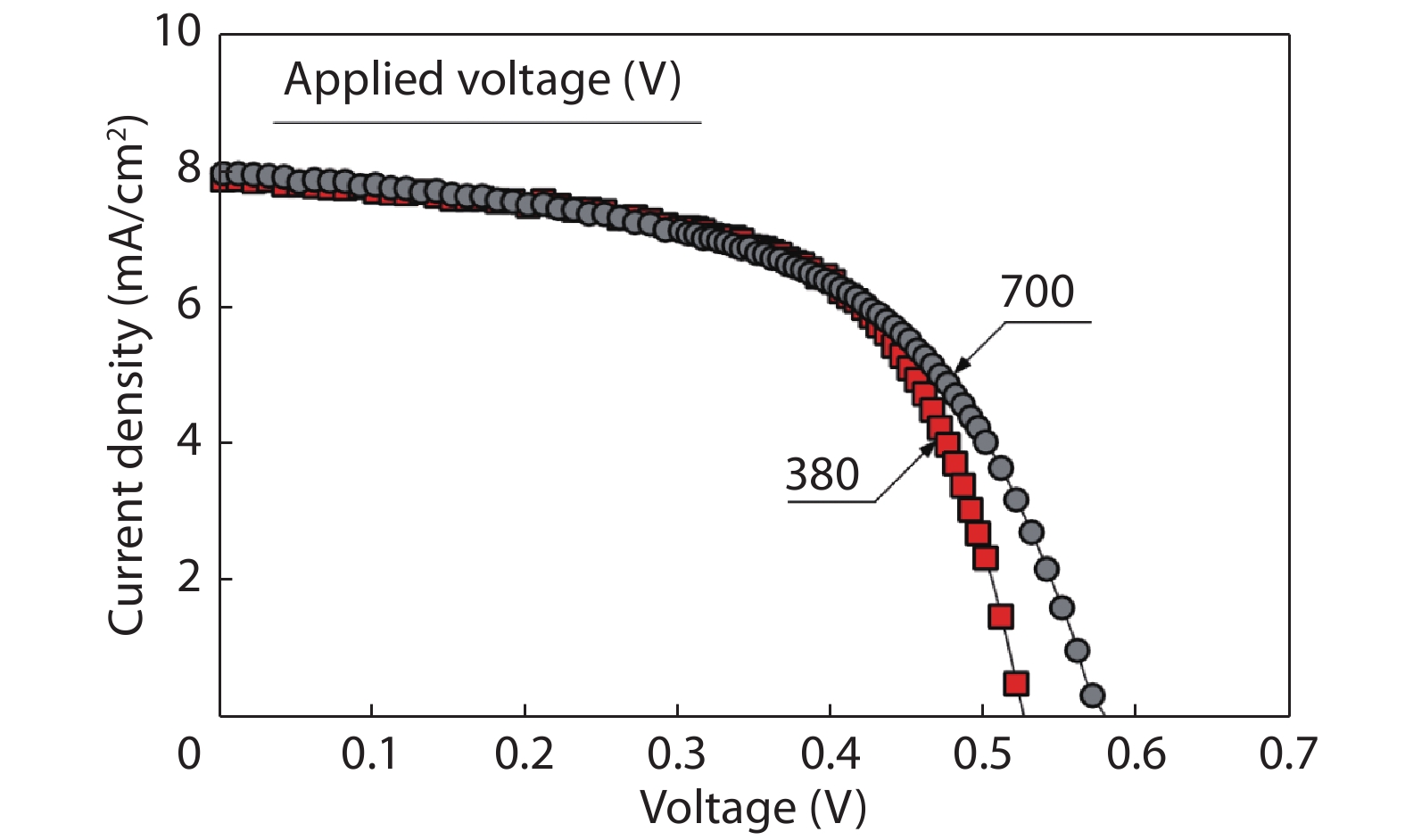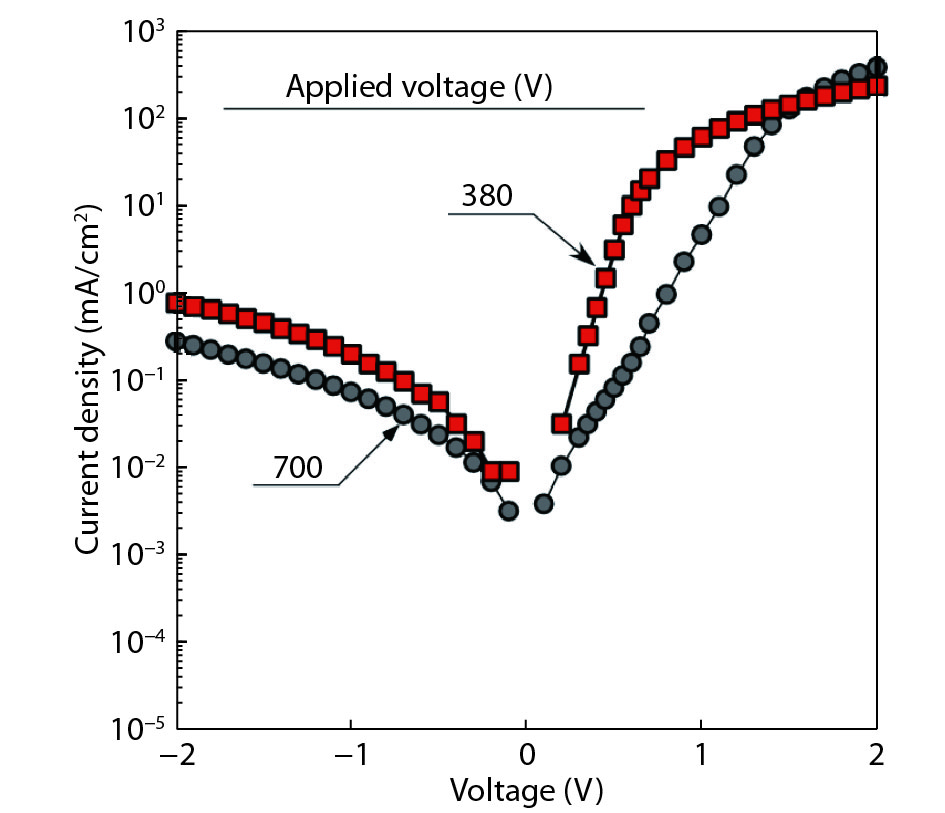| Citation: |
Toshihiro Miyata, Kyosuke Watanabe, Hiroki Tokunaga, Tadatsugu Minami. Photovoltaic properties of Cu2O-based heterojunction solar cells using n-type oxide semiconductor nano thin films prepared by low damage magnetron sputtering method[J]. Journal of Semiconductors, 2019, 40(3): 032701. doi: 10.1088/1674-4926/40/3/032701
****
T Miyata, K Watanabe, H Tokunaga, T Minami, Photovoltaic properties of Cu2O-based heterojunction solar cells using n-type oxide semiconductor nano thin films prepared by low damage magnetron sputtering method[J]. J. Semicond., 2019, 40(3): 032701. doi: 10.1088/1674-4926/40/3/032701.
|
Photovoltaic properties of Cu2O-based heterojunction solar cells using n-type oxide semiconductor nano thin films prepared by low damage magnetron sputtering method
DOI: 10.1088/1674-4926/40/3/032701
More Information
-
Abstract
We improved the photovoltaic properties of Cu2O-based heterojunction solar cells using n-type oxide semiconductor thin films prepared by a sputtering apparatus with our newly developed multi-chamber system. We also obtained the highest efficiency (3.21%) in an AZO/p-Cu2O heterojunction solar cell prepared with optimized pre-sputtering conditions using our newly developed multi-chamber sputtering system. This value achieves the same or higher characteristics than AZO/Cu2O solar cells with a similar structure prepared by the pulse laser deposition method.-
Keywords:
- Cu2O,
- AZO,
- solar cell,
- oxide thin film,
- magnetron sputtering
-
References
[1] N Asima, K Sopiana, S Ahmadib, et al. A review on the role of materials science in solar cells. Renew Sustain Energy Rev, 2012, 16: 5834. doi: 10.1016/j.rser.2012.06.004[2] A E Rakhshani. Preparation, characteristics and photovoltaic properties of cuprous oxide – a review. Solid-State Electron, 1986, 29: 7. doi: 10.1016/0038-1101(86)90191-7[3] G P Pollack. D Trivichi. Photoelectric properties of cuprous oxide. J Appl Phys, 1975, 46: 163. doi: 10.1063/1.321312[4] J Herion, E A Niekisch, G Scharl. Investigation of metal oxide/cuprous oxide heterojunction solar cells. Sol Energy Mater, 1980, 4: 101. doi: 10.1016/0165-1633(80)90022-2[5] L Papadimitriou, N A Economou, D Trivich. Heterojunction solar cells on cuprous oxide. Sol Cells, 1981, 3: 73. doi: 10.1016/0379-6787(81)90084-3[6] L C Olsen, F W Addis, W Miller. Experimental and theoretical studies of Cu2O solar cells. Sol Cells, 1982, 7: 247. doi: 10.1016/0379-6787(82)90050-3[7] W M Sears, E Fortin, J B Webb. Indium tin oxide/Cu2O photovoltaic cells. Thin Solid Films, 1983,103: 303. doi: 10.1016/0040-6090(83)90447-9[8] B P Rai. Cu2O solar cells: A review. Sol Cells, 1988, 25: 265. doi: 10.1016/0379-6787(88)90065-8[9] R N Briskman. A study of electrodeposited cuprous oxide photovoltaic cells. Sol Energy Mater Sol Cells, 1992, 27: 361. doi: 10.1016/0927-0248(92)90097-9[10] T Minami, Y Nishi, T Miyata, et al. High-efficiency oxide solar cells with ZnO/Cu2O heterojunction fabricated on thermally oxidized Cu2O sheets. Appl Phys Express, 2011, 4: 062301. doi: 10.1143/APEX.4.062301[11] Y S Lee, J Heo, S C Siah, et al. Ultrathin amorphous zinc-tin-oxide buffer layer for enhancing heterojunction interface quality in metal-oxide solar cells. Energy Environ Sci, 2013, 6: 2112. doi: 10.1039/c3ee24461j[12] T Minami, Y Nishi, T Miyata. High-efficiency Cu2O-based heterojunction solar cells fabricated using a Ga2O3 thin film as n-type layer. Appl Phys Express, 2013, 6: 044101. doi: 10.7567/APEX.6.044101[13] S W Lee, Y S Lee, J Heo, et al. Improved Cu2O-based solar cells using atomic layer deposition to control the Cu oxidation state at the p-n junction. Adv Energy Mater, 2014, 4: 1301916. doi: 10.1002/aenm.201301916[14] Y S Lee, D Chua, R E Brandt, et al. Atomic layer deposited gallium oxide buffer layer enables 1.2 V open-circuit voltage in cuprous oxide solar cells. Adv Mater, 2014, 26: 4704. doi: 10.1002/adma.v26.27[15] T Minami, Y Nishi, T Miyata. Heterojunction solar cell with 6% efficiency based on an n-type aluminum–gallium–oxide thin film and p-type sodium-doped Cu2O sheet. Appl Phys Express, 2015, 8: 022301. doi: 10.7567/APEX.8.022301[16] Y Ievskaya, R L Z Hoye, A Sadhanala, et al. Fabrication of ZnO/Cu2O heterojunctions in atmospheric conditions: Improved interface quality and solar cell performanceSol. Energy Mater Sol Cells, 2015, 135: 43. doi: 10.1016/j.solmat.2014.09.018[17] R L Z Hoye, R E Brandt, Y Ievskaya, et al. Perspective: Maintaining surface-phase purity is key to efficient open air fabricated cuprous oxide solar cells. APL Mater, 2015, 3: 020901. doi: 10.1063/1.4913442[18] T Minami, T Miyata, Y Nishi. Efficiency improvement of Cu2O-based heterojunction solar cells fabricated using thermally oxidized copper sheets. Thin Solid Films, 2014, 559: 105. doi: 10.1016/j.tsf.2013.11.026[19] T Minami, T Miyata, Y Nishi. Cu2O-based heterojunction solar cells with an Al-doped ZnO/oxide semiconductor/thermally oxidized Cu2O sheet structure. Sol Energy, 2014, 105: 206. doi: 10.1016/j.solener.2014.03.036[20] T Minami, Y Nishi, T Miyata. Cu2O-based solar cells using oxide semiconductors. J Semicond, 2016, 37: 014002. doi: 10.1088/1674-4926/37/1/014002[21] Nishi Y, Miyata T, Nomoto J, et al. High-efficiency Cu2O-based heterojunction solar cells fabricated on thermally oxidized copper sheet. Conf Rec 37th IEEE Photovoltaic Specialists Conf, 2011, 266[22] T. Minami, Y. Nishi, and T. Miyata. Impact of incorporating sodium into polycrystalline p-type Cu2O for heterojunction solar cell applications. Appl Phys Lett, 2014, 105: 212104. doi: 10.1063/1.4902879 -
Proportional views





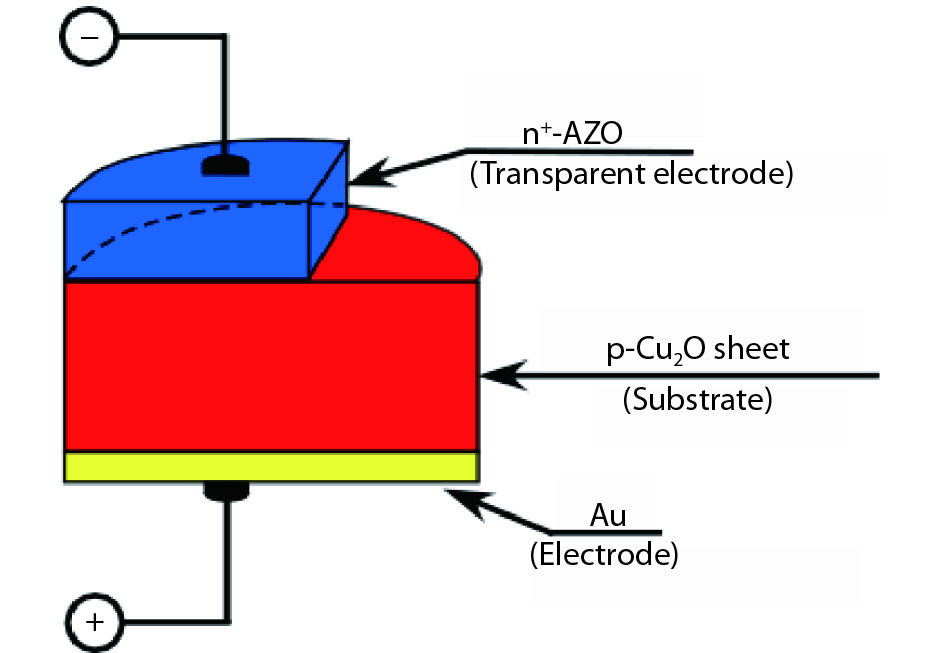
 DownLoad:
DownLoad:
